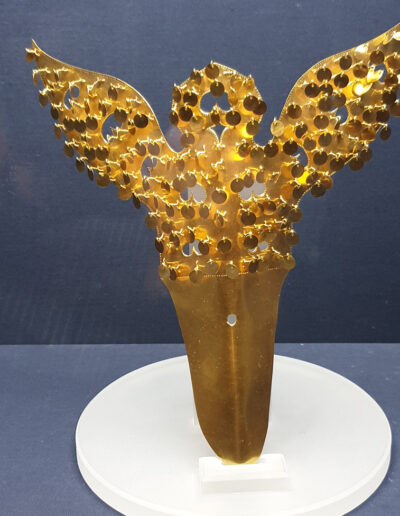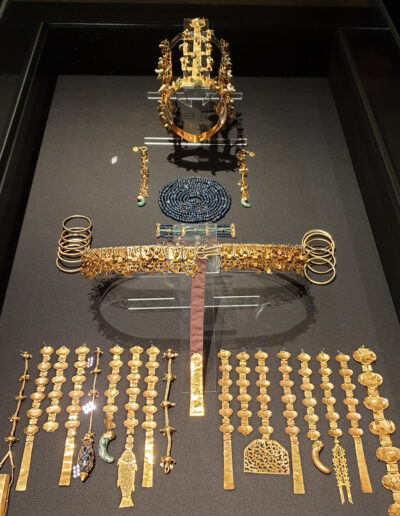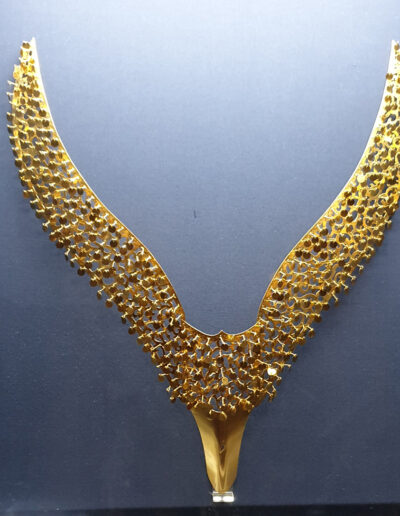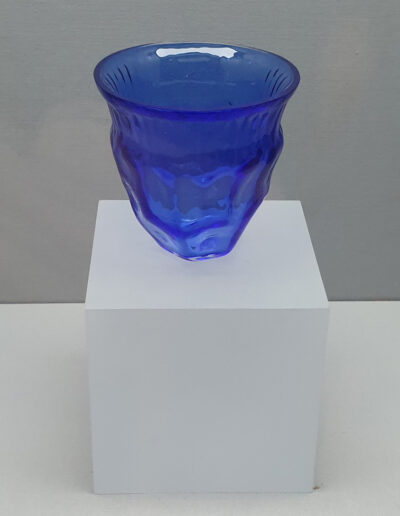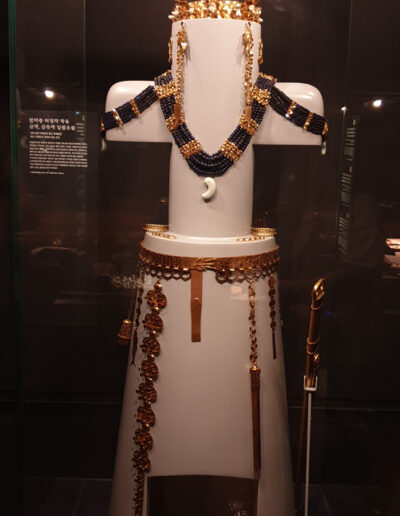The Gold crowns of Silla
500-700 CE
About the Object
Story of the Object
Teaching suggestions
Classroom Extras
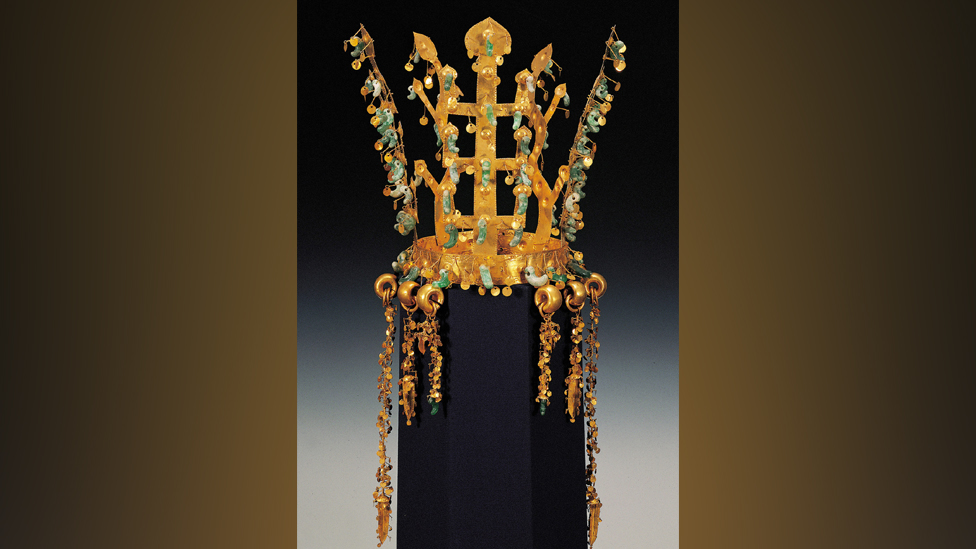
The Gold Crown from the North Mound of Hwangnamdaechong Tomb © Korea Heritage Service
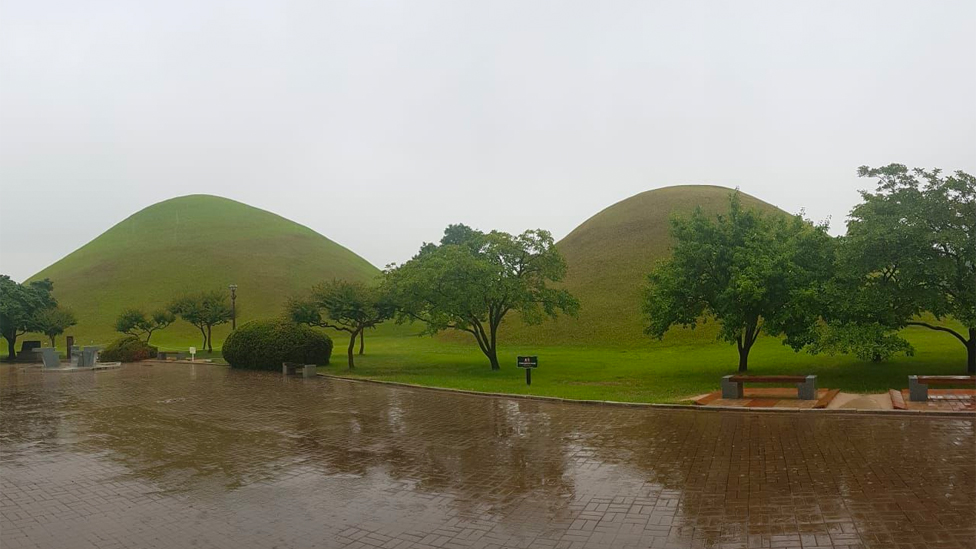
Burial mounds at Gyeongju
The Gold Crowns of Silla
The gold crowns were made in the Korean kingdom of Silla (57 BCE-935 CE) between the 5th and 7th centuries.
They were discovered in a series of mounds which housed the tombs of the Silla royal family in Gyeongju.
The tombs also contained other precious artefacts, many of which were made of gold.
Most of the treasure found in the tombs, including the crowns, are now to be seen in the Gyeongju National Museum or in the National Museum of Korea in Seoul.
A reconstruction of a tomb with replica artefacts can be seen in the Gyeongju National Park.
The Gold Crowns, and some of the other objects found within the tombs, have been identified as National Treasures of Korea, and the Gyeongju Historic Area, which contains the Tumuli Park Belt and the Royal Tombs, has been designated as a World Heritage Site.
The Gold Crowns of Silla
The crowns were made in the Korean kingdom of Silla.
In all six gold crowns have been discovered.
All were made over a short period of about 100 years.
The crowns have many similarities but there are some differences which are explained by the fact that they were made at slightly different times.
The crowns were made between the 5th and 7th centuries.
They were excavated in Gyeongju, the former capital of Silla.
It seems that Gyeongju is the only place in the world where so many gold crowns have been excavated.
This helps to explain why the Silla kingdom is often called the kingdom of gold crowns.
Gold was seen as a symbol of wealth and prosperity, status and power.
As a result, a gold crown was a visible sign of the authority and importance of the rulers of Silla.
Whereas the crowns made of pure gold were probably for kings, those crowns which were made from gilt-bronze or gold-plated bronze were probably for less important members of the royal family.
The gold crown from the Hwangnamdaechong tomb may well have been made for a queen because the body found within the tomb was female.
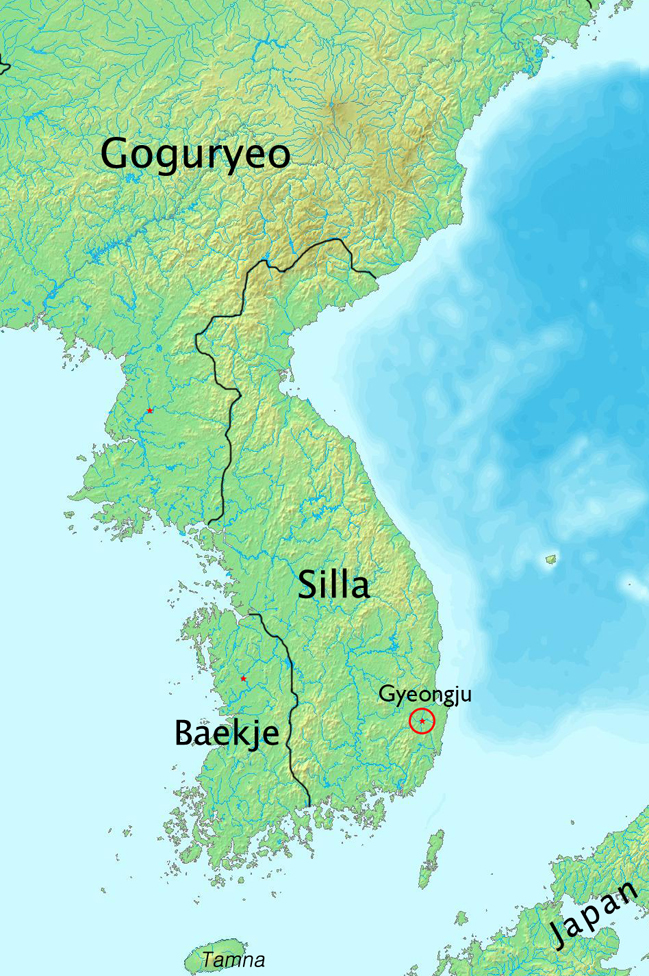
Map showing Gyeongju, capital of the Silla Kingdom, and the Three Kingdoms of Silla, Goguryeo, and Baekje (57 BCE – 668 CE)
The Royal Tombs
It seems that the burial mounds in Gyeongju were built for members of the royal family and for other very important people in the kingdom of Silla.
Besides the body of the person who had died, the tombs also contained various precious artefacts.
The tombs were built in a special way.
Large pits were dug and lined with wood.
The coffin of the dead person was placed on the floor of the pit which was covered with large boulders and a mound of earth.
There were no corridors.
This meant that grave robbers found it very difficult to access the graves for the treasure contained within them.
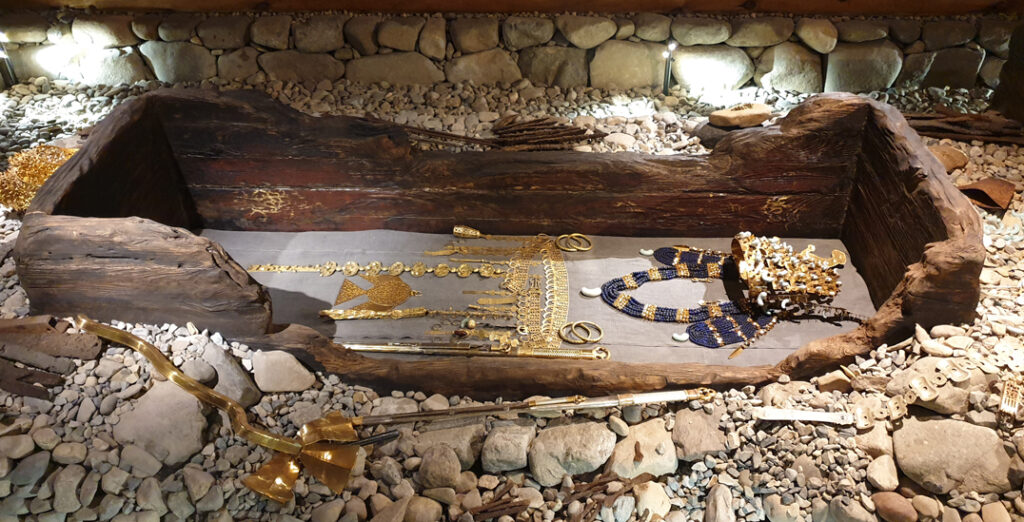
A reconstruction of the Cheonmachong Tomb at Gyeongju
The discovery of the first crown – the Geumgwanchong (or Gold Crown) Tomb
The tomb was excavated in 1921.
The story goes that one day when a house was being built in the area now known as Noseo-dong in Gyeongju, a group of children found some beads in a mound of soil.
At this time Korea was ruled by Japan and a Japanese police officer who was passing saw the beads and asked the children where they had found them.
The children showed him the place.
Digging in the soil revealed more artefacts. Once excavated, it was clear that the hill had been a burial site dating back to the early Silla period.
It seems that the tomb was built between 475 and 500 CE.
Many artefacts from the Silla period were dug out of the ground including the gold crown, which gave its name to the tomb, Geumgwanchong.
Archaeologists now believe that the grave did not belong to a king but to an important member of the royal family.
The contents of the tombs
The tombs not only contained gold crowns.
There was a vast array of precious objects.
In all, over 40,000 artefacts have been recovered by archaeologists.
They included gold, silver, and bronze vessels, gold and silver weapons, gilt-bronze plate armour, stoneware vessels, 20,000 mainly blue Indo-Pacific beads, and various horse fittings.
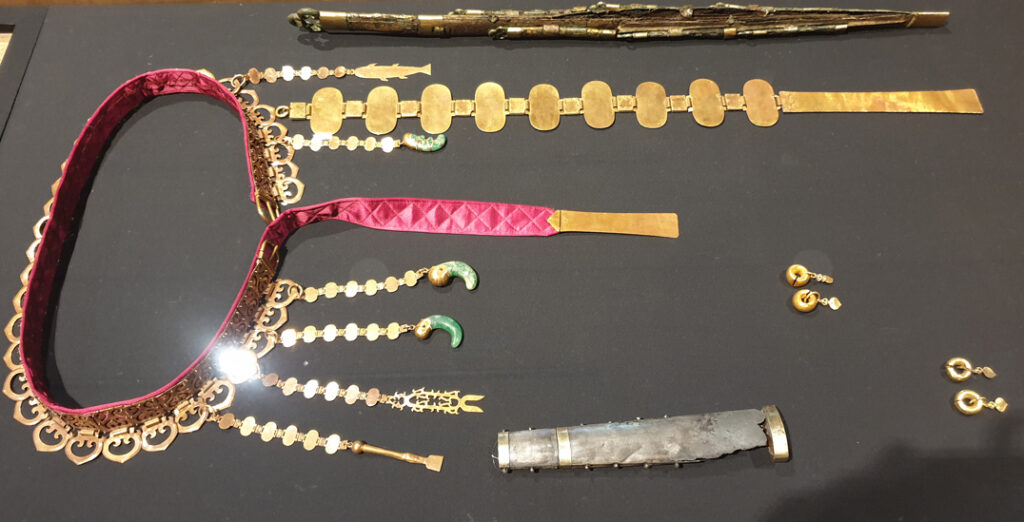
The gold belt from the Hwangnamdaechong Tomb
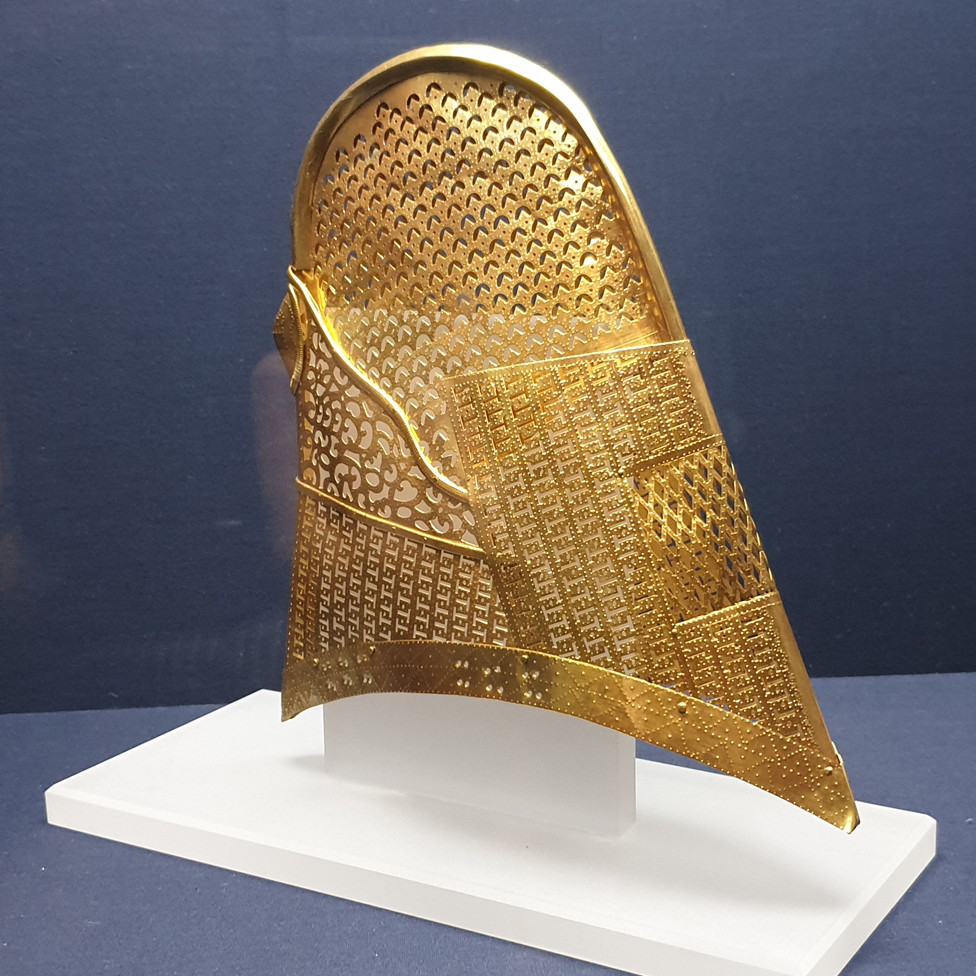
A gold cap used by important officials to denote their wealth and status
The Silk Roads
Although the kingdom of Silla was at the southeastern tip of the Korean peninsula, it is clear that the kingdom had forged links with other countries beyond the peninsula.
The archaeological remains discovered in the tombs ranged from objects made by skilled crafts people from across Central Asia, even as far away as the Mediterranean, as well as from Silla itself.
The principal explanation for the items making their way to Korea is trade.
Merchants would have travelled to and from Korea by sea.
However, they would have principally travelled by land using the Silk Roads which crossed Asia linking the countries of the Middle East to those of the Far East.
The Significance of the gold crowns
The Gold Crowns of Silla are significant in several ways and, when considering the significance of an object, it is appropriate to think about it on numerous levels.
On a global scale and in relation to world history, they are immensely significant because it appears that Gyeongju is the only place in the world where so many gold crowns have been excavated.
On a national level, the crowns tell us so much about the times in which they were created.
The crowns were made of gold and gold objects have for centuries been seen as symbols of wealth and prosperity, status and power. As a result, a gold crown was a visible sign of the authority and importance of the rulers of Silla.
The fact that several gold crowns were found reveals that the kingdom of Silla was indeed wealthy.
It also tells us that any grave robbers who had tried to find and remove any treasure from the tombs had failed spectacularly.
On the other hand, the intact nature of the burial tombs may also reveal the respect and reverence the people of Silla, and later times, had for their rulers.
The richness of the decoration and the exquisite nature of the workmanship in creating such wonderful objects demonstrates the extremely high standard of skill of the craftsmen who made these objects.
They also indicate the advanced expertise of the crown makers and suggest brilliant designers, careful planning and an unhurried process.
There was time to create the objects and the intricate parts, and this suggests a confidence amongst the rulers about the period in which they were made.
Besides the crafts people who made them, the gold crowns are also significant in relation to everyone else alive at the time.
For the kings themselves, they symbolised wealth and power.
For the general population, they inspired awe and wonder, created a pride in the wonderous craftmanship of the Korean goldsmiths, and displayed the supremacy of the monarchs and their families.
For those from foreign lands who met the kings and queens of Silla, they showed the dominance of the monarchs, their authority and wealth and, as a result, the need for the foreign dignitaries and diplomats to show respect and due deference.
For those today studying the history of Korea, the gold crowns provide a fascinating insight into:
- a world time period which is not as well-known as it should be for its skilled craft work
- a country, people and society which deserve much greater attention and admiration than they have traditionally received.
Retrieval practice
Why not create some short multi-choice quizzes to test what students can recall about the content they have just learned about? Create a quick test of 8, 10, 12 or 20 questions. Here are three examples:
1.The gold crowns were made in which Korean kingdom?
a) The Kingdom of Goguryeo
b) The Kingdom of Silla
c) The Kingdom of Baekje
2. Where were the crowns found?
a)In burial mounds in Gyeongju
b) In a large lake in Daejeon
c) In a temple near Incheon
3. It is believed that all the crowns were made over a period of how many years?
a)500 years
b) 250 years
c) 100 years
The Dig
You could create a starter or initial stimulus material activity here. Why not role play an archaeological dig in which the crowns were first found. To do this, get everyone in the room to kneel on the floor. Then read, act out together, or tell them the following:
“You are an archaeologist digging in the South Korean sun. Pick up your trowel and start to dig in the dirt.
“Dig carefully. Wait – something is glinting in the sun. Put down your trowel and pick up the brush.
“You don’t want to damage anything precious from the past. Keep brushing. Wow! I can see it now, this is quite incredible. I have never seen anything like it!”
Perhaps get the pupils to close their eyes whilst you have a picture of a crown projected to them.
Get them to open their eyes to see what they were digging. Then get them to list questions that they want to know the answer to about the crowns.
This works as an engaging start. You could the choose a line of enquiry to investigate this topic further.
Where else in the world?
There are many well-known sites around the world that contain burial mounds like the ones in Gyeongju.
Ask pupils to research other burial mound sites. Perhaps set a target of three other sites, or five, or 10.
This could be an individual or group project.
- Plot the sites on a map of the world. Even create a timeline showing when each of the burial mounds were created.
- Create fact files for the sites:
How many mounds were there?
When were they created?
When were they discovered, and how?
Who, and/or what was found?
How are the burial mounds displayed today? - Add a picture, photograph, or plan. Some good examples are:
Sutton Hoo, near Woodbridge, Suffolk, England (add link to official website, or provide a picture, or both??)
Bin Tepe, on the southern shore of Marmara Lake in Manisa Province, Turkey
The Qin tomb, near the city of Xi’an in Shaanxi, China
Crowns
Begin with a simple explanation of what crowns are and the functions they serve.
Perhaps give students a general definition.
For example: “a crown is a type of headdress worn by an important person, such as a king or queen. Crowns are usually used as a symbol of power and are worn when a monarch is crowned or at important occasions. They are often made from gold and silver and decorated with precious jewels”.
Ask pupils to research other well-known crowns. Perhaps set a target of 3, or 5, or 10. This could be an individual or group project.
Create fact files for each crown:
- Which country?
- When was it created?
- What materials were used?
- Who wears it? Or has worn it?
- Is the crown still used? If so, where is it kept when it is not in use?
- Add pictures.
There are many, many examples, from all over the world. Get pupils to identify similarities and differences.
Examples that are easier to find information on include: the Imperial State Crown of the United Kingdom; the Crown of the Holy Roman Empire (also called Crown Of Charlemagne); the Kiani Crown; the Imperial Crown of Pedro II of Brazil; the Golden Crown of the Sultan of Banten.
Burials across the world
In Gyeongju, we have seen than the Silla royal family were buried in burial mounds. You could ask your pupils to investigate how people in different cultures across the world were buried.
They could create fact files and plot on a world 5-10 different types of burial across the world. Some examples might include:
- Tibetan sky burials
- Madagascan dancing ceremonies.
- Nordic water burials
- ‘Death beads’ in South Korea
Pupils could show their knowledge by plotting general burials and burials of rulers to show their understanding of similarity and difference.
A timeline
Clearly the Silla Empire was an important era in Korean history. It has a thousand-year history lasting from circa: 57 BCE to 935 CE.
To provide your pupils with some context for this object you could ask them to create a timeline of the main events.
This Britannia Encyclopaedia link on the Three Kingdoms period gives a good overview.
They could also add some of the main objects from this period by watching this short video Korean history – Silla Kingdom on YouTube.
This was the period in which Buddhism came to Korea.
Key dates:
57 BCE
4 CE
57- 80 CE
356 – 402 CE
530 CE
576 – 650 CE
661 -681 CE
927 – 935 CE
Classroom Extras
Here you will find a number of images, video clips and website links which can be used as extras for teaching in the classroom or for use by pupils undertaking independent research.
Images
Study these photographs of the tombs and their contents:
Map
Select Google Maps options to view key locations for different objects:
Videos
Watch these films about the Crowns and Tombs:

Discover more online
Google Arts and Culture: travel back to the Silla era with the items defining the period at the Gyeongju National Museum
Google Arts and Culture: Silla, the Golden Kingdom of Korea
Wikipedia: The National Treasures of South Korea – the Crowns of Silla

